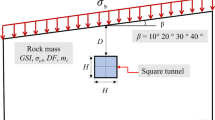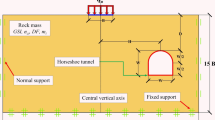Abstract
Convergence prediction of tunnels has always been one of the important issues of geotechnical projects. Developing prediction models is a good approach to predict convergence, when there is no knowledge of the possibility of convergence occurrence in the future. In this study, convergence rates of two tunnels from the Namaklan twin tunnel were predicted by different types of machine learning methods. Artificial neural networks (ANNs), multivariate linear regression (MLR), multivariate nonlinear regression (MNR), support vector regression (SVR), Gaussian process regression (GPR), regression trees and ensembles of trees (ET) were applied to predict the convergence rate (CR). The six parameters of cohesion (c), internal friction angle (Φ), uniaxial compressive strength of rock mass (σc), rock mass rating, overburden height (H) and the number of installed rock bolts (NB) were selected as predictor parameters. The dataset was collected via field investigations and laboratory experiments. The results showed that the MLP–ANN model can successfully predict the CR with the determination coefficient (R2) of 0.93. The RBF–ANN model is also successful in predicting the CR with R2 of 0.81. The SVR, MNR and MLR models were also constructed to obtain an empirical formula for predicting the CR. Comparing among the three models showed that the SVR model is more successful (R2 = 0.66) than the MNR and MLR models with R2 of 0.65 and 0.61, respectively. However, the SVR model is placed in the next rank of the ANN models. Among the rest models, except the ET model (R2 = 0.66), the RT and GPR models have no good capability for the prediction of the CR. In total, assessing the statistical indices indicated that the ANNs are superior to the other models in predicting the CR. However, the SVR model could be considered to be a reliable predictive model for convergence rate estimation.
















Similar content being viewed by others
References
Kontogianni, V.; Psimoulis, P.; Stiros, S.: What is the contribution of time-dependent deformation in tunnel convergence? Eng. Geol. 82(4), 264–267 (2006)
Kontogianni, V.A.; Stiros, S.C.: Predictions and observations of convergence in shallow tunnels: case histories in Greece. Eng. Geol. 63(3–4), 333–345 (2002)
Eberhardt, E.: Numerical modelling of three-dimension stress rotation ahead of an advancing tunnel face. Int. J. Rock Mech. Min. Sci. 38(4), 499–518 (2001)
Paternesi, A.; Schweiger, H.F.; Scarpelli, G.: Finite element simulations of twin shallow tunnels. In: ISRM Regional Symposium-EUROCK 2015 2015. International Society for Rock Mechanics and Rock Engineering
Yazdani, M.; Sharifzadeh, M.; Kamrani, K.; Ghorbani, M.: Displacement-based numerical back analysis for estimation of rock mass parameters in Siah Bisheh powerhouse cavern using continuum and discontinuum approach. Tunn. Undergr. Sp. Technol. 28, 41–48 (2012)
Chen, R.-P.; Lin, X.-T.; Kang, X.; Zhong, Z.-Q.; Liu, Y.; Zhang, P.; Wu, H.-N.: Deformation and stress characteristics of existing twin tunnels induced by close-distance EPBS under-crossing. Tunn. Undergr. Sp. Technol. 82, 468–481 (2018)
Barton, N.: Some new Q-value correlations to assist in site characterisation and tunnel design. Int. J. Rock Mech. Min. Sci. 39(2), 185–216 (2002)
Mahdevari, S.; Torabi, S.R.: Prediction of tunnel convergence using artificial neural networks. Tunn. Undergr. Sp. Technol. 28, 218–228 (2012)
Adoko, A.-C.; Jiao, Y.-Y.; Wu, L.; Wang, H.; Wang, Z.-H.: Predicting tunnel convergence using multivariate adaptive regression spline and artificial neural network. Tunn. Undergr. Sp. Technol. 38, 368–376 (2013)
Zarei, H.; Ahangari, K.; Ghaemi, M.; Khalili, A.: A convergence criterion for water conveyance tunnels. Innov. Infrastruct. Solut. 2(1), 48 (2017)
Rajabi, M.; Rahmannejad, R.; Rezaei, M.; Ganjalipour, K.: Evaluation of the maximum horizontal displacement around the power station caverns using artificial neural network. Tunn. Undergr. Sp. Technol. 64, 51–60 (2017)
Hajihassani, M.; Kalatehjari, R.; Marto, A.; Mohamad, H.; Khosrotash, M.: 3D prediction of tunneling-induced ground movements based on a hybrid ANN and empirical methods. Eng. Comput. (2019). https://doi.org/10.1007/s00366-018-00699-5
Chen, R.-P.; Zhang, P.; Kang, X.; Zhong, Z.-Q.; Liu, Y.; Wu, H.-N.: Prediction of maximum surface settlement caused by earth pressure balance (EPB) shield tunneling with ANN methods. Soils Found. 59(2), 284–295 (2019)
Ren, Q.; Wang, G.; Li, M.; Han, S.: Prediction of rock compressive strength using machine learning algorithms based on spectrum analysis of geological hammer. Geotech. Geol. Eng. 37(1), 475–489 (2019)
Seker, S.E.; Ocak, I.: Performance prediction of roadheaders using ensemble machine learning techniques. Neural Comput. Appl. 31(4), 1103–1116 (2019)
Ghasemi, E.; Kalhori, H.; Bagherpour, R.; Yagiz, S.: Model tree approach for predicting uniaxial compressive strength and Young’s modulus of carbonate rocks. Bull. Eng. Geol. Environ. 77(1), 331–343 (2018)
Pham, B.T.; Prakash, I.; Bui, D.T.: Spatial prediction of landslides using a hybrid machine learning approach based on random subspace and classification and regression trees. Geomorphology 303, 256–270 (2018)
Taha Consulting Engineers Company: Report of geological and engineering geology study of III and IV parcels of Namaklan tunnel. In. Tehran, Iran. (2014) (in Persian)
Yilmazkaya, E.; Dagdelenler, G.; Ozcelik, Y.; Sonmez, H.: Prediction of mono-wire cutting machine performance parameters using artificial neural network and regression models. Eng. Geol. 239, 96–108 (2018)
Spss I. IBM SPSS statistics version 21. International Business Machines Corp., Boston, MA (2012)
Tu, J.V.: Advantages and disadvantages of using artificial neural networks versus logistic regression for predicting medical outcomes. J. Clin. Epidemiol. 49(11), 1225–1231 (1996)
Koopialipoor, M.; Tootoonchi, H.; Armaghani, D.J.; Mohamad, E.T.; Hedayat, A.: Application of deep neural networks in predicting the penetration rate of tunnel boring machines. Bull. Eng. Geol. Environ. 78(8), 6347–6360 (2019)
Moosazadeh, S.; Namazi, E.; Aghababaei, H.; Marto, A.; Mohamad, H.; Hajihassani, M.: Prediction of building damage induced by tunnelling through an optimized artificial neural network. Eng. Comput. 35(2), 579–591 (2019)
Moody, J.; Darken, C.J.: Fast learning in networks of locally-tuned processing units. Neural Comput. 1(2), 281–294 (1989)
MATLAB and Statistics Toolbox Release 2018a The MathWorks, I., Natick, Massachusetts, United States (2018)
Bui, D.T.; Tuan, T.A.; Klempe, H.; Pradhan, B.; Revhaug, I.: Spatial prediction models for shallow landslide hazards: a comparative assessment of the efficacy of support vector machines, artificial neural networks, kernel logistic regression, and logistic model tree. Landslides 13(2), 361–378 (2016)
Hong, H.; Pradhan, B.; Jebur, M.N.; Bui, D.T.; Xu, C.; Akgun, A.: Spatial prediction of landslide hazard at the Luxi area (China) using support vector machines. Environ. Earth Sci. 75(1), 40 (2016)
Breiman, L.; Friedman, J.; Olshen, R.A.; Stone, C.J.: Classification and regression trees. Chapman & Hall, New York (1984)
Tomczyk, A.M.; Ewertowski, M.: Planning of recreational trails in protected areas: application of regression tree analysis and geographic information systems. Appl. Geogr. 40, 129–139 (2013)
Dietterich, T.G.: An experimental comparison of three methods for constructing ensembles of decision trees: bagging, boosting, and randomization. Mach. Learn. 40(2), 139–157 (2000)
Rasmussen, C.E.: Gaussian processes in machine learning. In: Summer School on Machine Learning, pp. 63–71. Springer, Berlin, Heidelberg (2003)
Pal, M.; Deswal, S.: Modelling pile capacity using Gaussian process regression. Comput. Geotech. 37(7–8), 942–947 (2010)
Seeger, M.; Williams, C.; Lawrence, N.: Fast forward selection to speed up sparse Gaussian process regression. EPFL (2003)
Quiñonero-Candela, J.; Rasmussen, C.E.: A unifying view of sparse approximate Gaussian process regression. J. Mach. Learn. Res. 6(Dec), 1939–1959 (2005)
Yuan, J.; Wang, K.; Yu, T.; Fang, M.: Reliable multi-objective optimization of high-speed WEDM process based on Gaussian process regression. Int. J. Mach. Tool Manufact. 48(1), 47–60 (2008)
Williams, C.K.: Prediction with Gaussian processes: From linear regression to linear prediction and beyond. In: Learning in Graphical Models, pp. 599–621. Springer, Dordrecht (1998)
Williams, C.K.; Rasmussen, C.E.: Gaussian processes for regression. In: Advances in Neural Information Processing Systems, pp. 514–520. MIT Press, Denver, CO, USA (1996)
Author information
Authors and Affiliations
Corresponding author
Rights and permissions
About this article
Cite this article
Torabi-Kaveh, M., Sarshari, B. Predicting Convergence Rate of Namaklan Twin Tunnels Using Machine Learning Methods. Arab J Sci Eng 45, 3761–3780 (2020). https://doi.org/10.1007/s13369-019-04239-1
Received:
Accepted:
Published:
Issue Date:
DOI: https://doi.org/10.1007/s13369-019-04239-1




